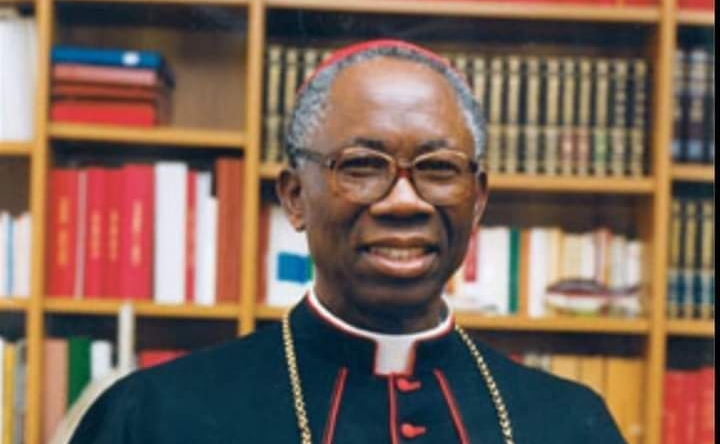(TT) – Cardinal Arịnze emerged the first Ìgbò Archbishop of Ọnịcha about 6 days before the Nigerian Genocidal War on Biafra broke out in July 1967
My attention was recently drawn to a Facebook post that had to do with Cardinal Arịnze’s response to an interview about early Ìgbò Christianization.
While I remained reticent to the content, the post eventually reminded me the many things I have, over the years, reflecte7d upon about the man himself and his large but little-known place in Ìgbò history beyond the Catholic circles.
A little of him begs to be explored, if I can try. By November 1, 2022 (this year), FRANCIS ANỊZỌBA ARỊNZE would be exactly 90 years old having been born on November 1, 1932. Arịnze—the son of Arịnze Nwankwụ—is from Ọdịda Village in Eziowele, a town in Idemmili LGA of the present-day Anambra State.
At 90, Francis Arịnze has outlived the indigenous pioneer leaders and icons of Ìgbò Catholicism with whom he built the behemoth of what is today the Catholic enterprise among the Ìgbò (both within Ìgbòland and outside of it). Having lived this long as an important historical reference, Arịnze’s life—(for anyone who values to understand the Christianization journey of the Ìgbò)—is a deeply consequential one.
My hope is that his biographer, whoever it is or will be, will do a dispassionate, thorough and critical job of unraveling his life, essentially for Ìgbò social and church history.
Arịnze’s life is a deeply consequential one for the Ìgbò because he was very lucky to have started out very young and was able to live through all the major episodes as a major actor up till this moment in 21st century. It is no small feat in history!Not many Ìgbò people know that Francis Arịnze was once famously known throughout the world as “the youngest archbishop in Africa” (arguably beyond the Catholic Christendom).
Arịnze became a bishop few months before he turned 33 in 1965. And, at 34, just about five months before his 35th birthday in 1967, he was pronounced an archbishop—actually the Archbishop of Ọnịcha and the Metropolitan of all of its ecclesiastical province.
By being “Metropolitan of Ọnịcha Ecclesiastical Province” at the time, the whole of the Catholic empire in Ìgbòland (except that of the West Niger Ìgbò) came under Arịnze’s leadership and direction. He was only 34 going to 35!
Beyond Arịnze’s Bishopric and Cardinal status, very little is known of his days as “Fada Arịnze” and his role in Michael Ọkpara’s revolutionary government in the 1960s. With the establishment of St Charles Teacher Training College and Christ the King College in 1928 and 1933 respectively, all in Ọnịcha, the Catholic Irish missionaries began a revolutionary education campaign that will rival that of their counterpart, the CMS.
They dominated and piloted this education sector of the Catholic enterprise in Ìgbòland until 1960s when the campaign for the “Nigerianization” of government and influential positions in Nigeria was at fever pitch. The Irish missionaries came under attack and were accused of holding their positions too tight in Ìgbòland.
And so, with the resignation of Fr J. P. Jordan as the secretary of Catholic education in Eastern Nigeria, Rev Fr Francis Arịnze took over as the Catholic Education Secretary of Eastern Nigeria with his office in Enugwu at the time.
Fr Arịnze saw to the expansion and erection of more Catholic schools at the time in Ọkpara’s government. He was about the age of 30—32. It was from this position that Arịnze went on to become a bishop. His becoming a bishop and later archbishop was not without some internal and external politics.
This brings me to say that not many Ìgbò people know that the presence or existence of the French-dominated CSSp (the Holy Ghost Fathers) in Ìgbòland early in the 20th century and late 19th century was a source of anguish to the British who owned the Nigerian colony.
The CSSp—an abbreviation for “Congregatio Sanctum Spiritum”—that brought Christianity to Ìgbòland is a French Catholic establishment and by extension, an arm of the colonial machinery of France who “scrambled” the West Africa with Britain.
To scuttle their influence in Ìgbòland early in the 20th century, the British colonial forces in Nigeria politically manipulated the Vatican to replace the CSSp leadership of Catholicism in Ìgbòland with their Irish neighbors.
This was how the famous Bishop Ignatius Shanahan and other Irish missionaries flooded Ìgbòland until the war erupted in 1967. Professor F. K. Ekechi has documented this political move by Britain in his book, “Missionary Enterprise and Rivalry in Ìgbòland, 1857—1914.”
However, this Irish-dominated CSSp that replaced the French was reluctant to allow natives hold positions of influence in the Catholic enterprise in Ìgbòland, especially when the native was not a CSSp priest. Fr Francis Arịnze was a priest of the Secular Institute and not of the CSSp.
So, his appointment as a deputy (coadjutor) bishop to a CSSp Archbishop of Ọnịcha in the person of Archbishop Charles Heerey did not excite the Irish elements in Ìgbòland.
In fact, as late Professor Ikenga Ozigbo had revealed, the CSSp even made moves to upstage Arịnze from becoming an archbishop when Heerey died in February of 1967 by trying to influence the appointment of Bishop Godfrey Okoye (an Ìgbò CSSp) in Port-Harcourt as the Archbishop of Ọnịcha.
In the end, as the circumstances played out for him, Arịnze emerged the first Ìgbò Archbishop of Ọnịcha about 6 days before the Nigerian Genocidal War on Biafra broke out in July 1967.
Archbishop Francis Anịzọba Arịnze, 35, became the war-time leader of the Catholic faith in Ìgbòland and remained its leader after the war and throughout the postwar years of the 1970s and half of the 1980s. It must be mentioned that over 200 Irish missionaries (priests and nuns) fled Ìgbòland in 1967 as soon as the war broke out.
Only a few remained to help the populace. The Caritas that later came to our people’s help through the provisions of food and airlifts was a German Catholic establishment and not that of the Irish!
Many are unaware of the important roles Arịnze played both locally and internationally during the war as the president of the Biafran Catholic Bishops.
At Rome and at Uganda, Arịnze courageously made fascinating and forceful arguments (no matter their political connotations) in favor of the Biafran populace which helped the relief materials to keep coming to Biafra despite the wicked efforts and machinations of the Nigerian government to stop their inflow through high-powered international politics.
In fact, at one time during the World Council of Churches (WCC) meeting in Kampala (capital of Uganda) around 1969, Arịnze was barred from speaking as a “Biafran” in order not to offend the Nigerian representatives who were also present at the meeting—the political interpretation being that the WCC was avoiding to be accused of recognizing the sovereignty of a “breakaway” Biafra.
In another instance, Bola Ige, representing Nigeria, advised another international colloquium to remove the word “Biafra” in the addresses if it did not want to be seen as anti-Nigeria.
A further examination of this aspect of the war consolidates the fact that Biafra was actually fighting international forces with their various interests more than it was fighting Nigeria.
Thankfully, Professor Nicholas Omenkà has documented these events and some of the speeches of Arịnze during the war which are barely known or seen anywhere in Ìgbò archives. When the war ended in 1970, Archbishop Arịnze embarked on the reconstruction and rehabilitation of the Catholic empire in Ìgbòland.
Under Arịnze as the postwar leader of Ìgbò Catholicism, the first-time vocation boom among Ìgbò Catholics began. Contrary to what happened before the war when parents discouraged and prevented their children from going to the seminary or nunnery to become priests and nuns, many Ìgbò boys and girls flooded the seminary and convent schools to become Catholic priests and nuns.
The attraction being the growing social prestige and economic security the pre-war Ìgbò catholic priests had begun to enjoy after the Irish expatriate missionaries had vacated.
With the wide-spread poverty and economic insecurities in Ìgbòland after the war, it was understandable and likely that there would be such a vocation boom which also was a good response for the need of a new and indigenous manpower for the Catholic enterprise in Ìgbòland.
Arịnze was leading this revolution. It bears mentioning that there seem to be two eras of explosion of Ìgbò Catholicism: One being during the Shanahan era (1905—1920s) when there was mass movement of Ìgbò people (in thousands) to Catholicism; the second being the Arịnze era (after the war) when numerous Ìgbò boys and girls began to express interest in priestly and sisterly vocations.
A cursory look at the record of Ìgbò priests and nuns ordained/ professed from 1970s shows an astonishing and exponential increase in vocations when compared to the years before the war. I am hoping that a historian, in future, would take up this phenomenon and give us a better and critical view of how this vocational boom happened and what would have been if the Irish had not left and if the war had not happened.
Also, under Arịnze as the Archbishop of Ọnịcha, the Charismatic Movement penetrated the Ìgbò Catholicism despite his episcopal resistance to it. In fact, something personal had weakened his official resistance to the Movement’s penetration, making him to reluctantly allow the Movement a little opportunity.
I am sure that looking back now, Arịnze would never have imagined that the Charismatic Movement in Ìgbò Catholicism would grow so wide and wild today that it has churned out crusade grounds scattered all over Ìgbòland with many Ìgbò catholic priests heading them.
This aspect of Arịnze’s leadership has been documented by late Professor Ògbú Kalụ in his book, “African Pentecostalism: An Introduction.” There are other aspects of the tremendous changes and revolutionary moments that happened in Ìgbò Catholicism under Cardinal Arịnze as the Archbishop of Ọnịcha but those would be for another history text.
Again, many Ìgbò Catholics do not know that the historic feat of canonizing a deceased Black African catholic priest/monk in the person of Fr Tansi was Arịnze’s personal pursuit. Tansị who was a Catholic priest in Dunukọfịa (in today’s St Anthony’s Ụmụdiọka) had mentored Arịnze as a boy up till his young adulthood.
Arịnze was deeply connected to Tansị emotionally that he never hesitated to pursue his canonization with his powers and office as an Archbishop and Cardinal. Arịnze brought the newly consecrated Pope John Paul II to Nigeria (Ọnịcha) in 1982.
That first pope’s visit to Nigeria was a powerful catalyst for Catholicism in Ìgbòland and also a game changer for Arịnze himself. Three years later in 1985, Arịnze was pronounced a Cardinal by Pope John Paul II.
Alongside the late Dominic Cardinal Ekandem of Calabar, Arịnze became one of the earliest Cardinals in Nigeria and West Africa and has remained so till this moment. Arịnze, it must be emphasized, has really lived a deeply consequential life that must be thoroughly examined.
Of the notable pioneer/first-generation Ìgbò leaders and shapers of Catholicism among the Ìgbò and in Ìgbòland starting from John Cross Anyọgụ, Godfrey Okoye, Mark Unegbu, Stephen Ezeanya, Michael Eneja, Emmanuel Ótè, Albert Obiefuna, Gregory Ọchịagha and others I cannot remember now, Arịnze is about the only person alive today and still reportedly healthy.
If you are an Ìgbò from a Catholic family especially from Anambra areas, try checking the Catholic baptismal cards/birth certificates of your grandparents or parents and you are likely to see the name “Archbishop F. A Arịnze” as the one who gave them their sacrament of confirmation (ị́kwọ aka n’isi, as it was called).
That’s how old the influence of Arịnze is in Ìgbò Catholicism and has survived till this day. I do not know any other Ìgbò Catholic person who has been more powerful, more influential, more privileged and luckier than him.He has been accused of using this power, position and influence built, consolidated over the years and exercised from the Vatican to install his “boys” as Catholic bishops all over Ìgbòland and beyond.
This accusation became public and loud with the Ahịara Mbaise Diocese rejection of Bishop Ọkpalaeke as their bishop in the 2010s.After all is said and done, I am of the opinion that Francis Anịzọba Arịnze lived a deeply consequential life that deserves critical attention and examination because it impacted on several generations of Ìgbò people and Ìgbò history in particular.
Once again, I hope his biographer would do justice to drawing apart the entire mass of his life to enable a better understanding of how the Ìgbò have come to become what they are today.





